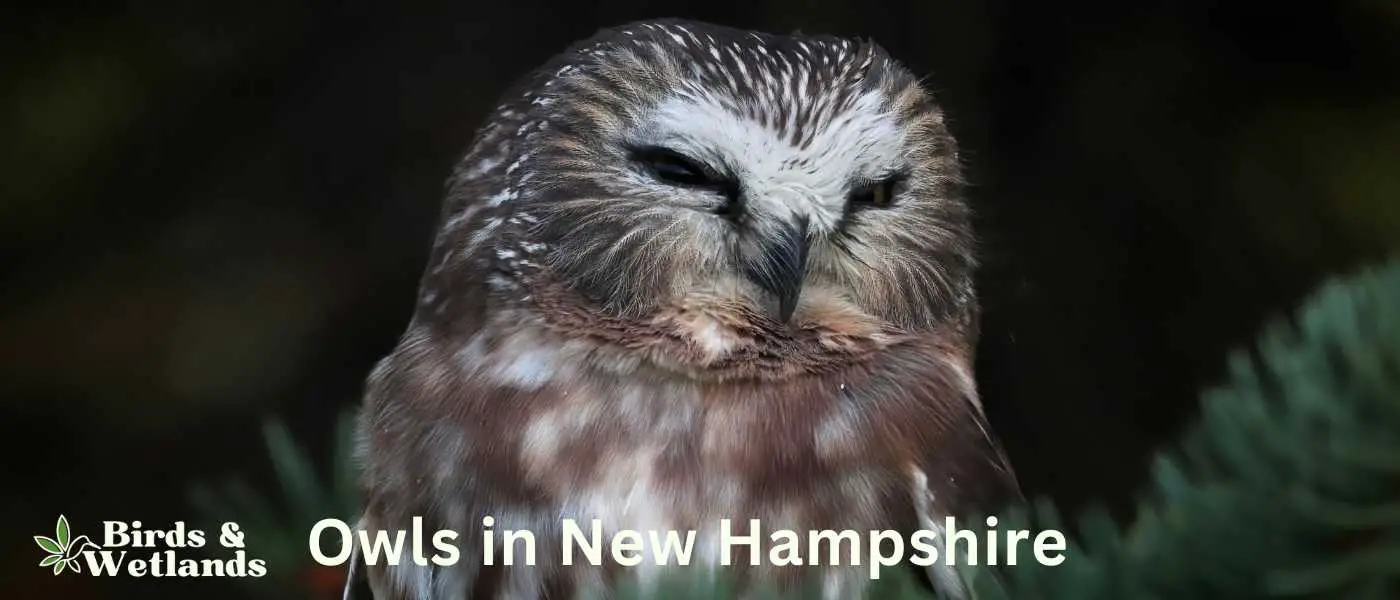Across the diverse habitats of New Hampshire, from its northern hardwood forests to its expansive wetlands and Appalachian foothills, a remarkable array of owls thrives. The owl species in New Hampshire range from the petite Northern Saw-whet Owls to the stately Great Horned Owls, each exhibiting unique adaptations and behaviors specific to their environments.
New Hampshire’s Owls
| Owl Species | Frequency in New Hampshire | Presence in New Hampshire | Specific Locations in New Hampshire |
|---|---|---|---|
| Great Horned Owl | Common | Year-round | Throughout the state |
| Short-eared Owl | Uncommon | Winter | Wetlands, marshes |
| Northern Saw-whet Owl | Common | Year-round | Dense coniferous or mixed forests |
| Barred Owl | Common | Year-round | Wooded areas |
| Eastern Screech-Owl | Common | Year-round | Wooded areas, often near water |
| Long-eared Owl | Uncommon | Winter | Dense stands of trees near open areas |
| Snowy Owl | Rare | Winter | Coastal areas, open fields |
| Great Gray Owl | Rare | Winter | Northern boreal forests |
- Great Horned Owl: These owls are very adaptable and can be found in a variety of habitats, from deserts to forests to city parks.
- Short-eared Owl: Typically found in open areas, such as meadows, marshes, and agricultural fields. They’re most active during the day in the winter months.
- Northern Saw-whet Owl: This small owl species prefers dense thickets or forests. They are often found in coniferous forests but can also inhabit deciduous forests.
- Barred Owl: They prefer large, mature forests, both deciduous and mixed deciduous-coniferous. They are also often found near water.
- Eastern Screech-Owl: These owls prefer open mixed forests, deciduous forests, parklands, wooded suburban areas, riparian woods along streams and wetlands, and orchards.
- Long-eared Owl: These secretive birds tend to inhabit dense forests or woodlands near open fields.
- Snowy Owl: These Arctic birds are occasionally found in New Hampshire during the winter, often in large open areas like airports, beaches, or fields.
- Great Gray Owl: Rare in New Hampshire, this bird prefers dense coniferous or mixed woodlands, usually near open fields or meadows.
Owl Species Found in New Hampshire
Great Gray Owl (Strix nebulosa)
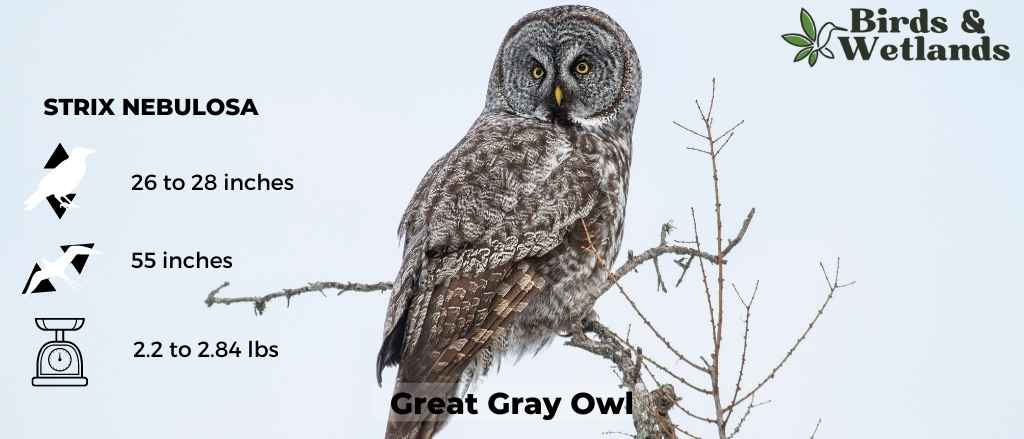
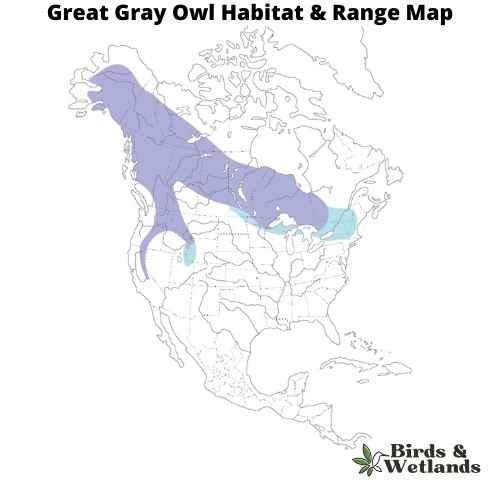
Great Gray Owl Sound
Scientific Name: Strix nebulosa
Length: 26 in to 28 in
Wingspan: 56 to 60 in
Weight:2.2 lb to 2.85lb
The Great Gray Owl, or Strix nebulosa, is a very large owl, native to the boreal forests across North America and Eurasia. Despite its great size, it’s more so known for its impressive appearance rather than its weight, as it is outweighed by several other large owl species.
The Great Gray Owl has a large, rounded head with a grey face and yellow eyes, surrounded by concentric circles of dark and light feathering. It is known for its bow-tie-shaped white moustache stripe and black chin spot.
One of the distinguishing characteristics of this owl is its elongated tail, which makes it appear much larger than it actually is. The plumage is mostly grey with a unique pattern of fine white, gray, and brown streaks and bars. Despite its large size, its diet primarily consists of small rodents, like voles and pocket gophers.
Great Gray Owls prefer dense coniferous forests, often near open meadows or bogs. Rather than building their own nests, they typically use nests previously built by other large birds, such as hawks or crows. They also occasionally nest in broken-top trees or on man-made structures.
Great Horned Owl (Bubo virginianus)

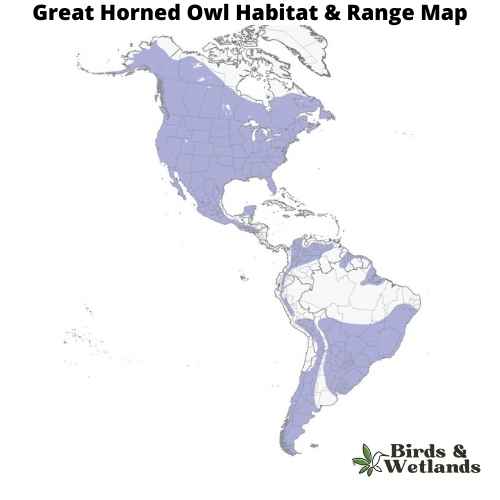
Great Horned Owl Sound
Scientific Name:Bubo virginianus
Length: 18.1-24.8 in
Wingspan: 39.8-57.1 in
Weight: 32.1-88.2 oz
The Great Horned Owl is a large owl with long wings and a large head. It’s one of the most common owls in North America.
Great Horned Owls are large, stocky birds with soft feathers that are gray to brown on their backs and white on their chests. Their faces are characterized by two black “ear” tufts, which can be raised or flattened depending on the owl’s mood. The eyes are yellow, orange, or red in color.
The habitat of the Great Horned Owl is a variety of different environments such as forests and deserts. They also live near water sources such as lakes, streams and rivers where they can hunt for fish.
The diet of the Great Horned Owl consists primarily of small mammals such as mice and rats; however they will also eat other rodents such as squirrels, rabbits and porcupines. They have been known to eat skunks too.
Eastern Screech-Owl (Megascops asio)


Eastern Screech-Owl Sound
Scientific Name: Megascops asio
Length: 6 to 10 in
Wingspan: 8 to 24 in
Weight: 4 – 8.5 oz
The Eastern Screech-Owl is a small owl species native to most wooded environments of the eastern half of North America, from the Canadian provinces to Florida and Texas.
Eastern Screech-Owls are relatively small and exhibit a complex pattern of gray or reddish-brown coloration, which provides excellent camouflage against tree bark.
These owls are known for their distinctive call, which is often described as a haunting trill or a whinny-like sound. Despite their name, they do not actually produce a “screech.”
Eastern Screech-Owls feed on a variety of prey, ranging from small mammals and birds to insects and even earthworms. It is primarily nocturnal, hunting at night from a low perch and swooping down onto prey.
Eastern Screech-Owls nest in tree cavities or abandoned woodpecker nests, but they readily adapt to nesting boxes where natural cavities are not available. They typically lay between 2 to 6 eggs, which are incubated primarily by the female.
Barred Owl (Strix varia)

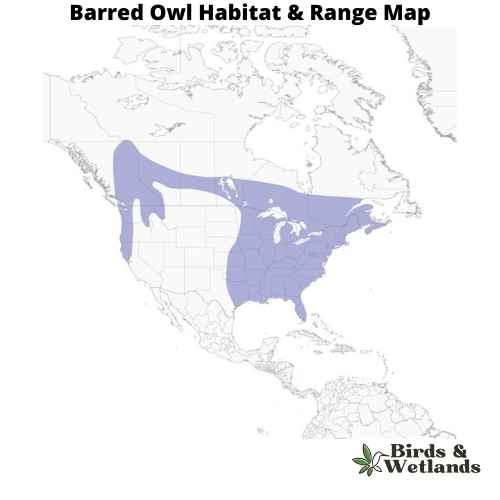
Barred Owl Sound
Scientific Name: Strix varia
Length: 40 to 63 cm (16 to 25 in)
Wingspan: 96 to 125 cm (38 to 49 in)
Weight: 468 to 1,150 g
The Barred Owl is a medium-sized owl with a barred pattern on its chest and belly. They have large yellow eyes that allow them to see well in low light conditions. Their ears are not very large which means they do not hear very well but they have excellent hearing abilities which allow them to detect sounds up to 1 mile away. Their feathers are brown and streaked with white, and they have black bars on their chests and wings.
Their habitats include forests, woodlands, orchards, parks, farmland and suburban backyards.
Barred Owls (also known as hoot owl) eat small mammals such as mice, rats and squirrels. They also eat insects such as beetles or grasshoppers. These owls hunt during the day when it is light out so that they can see their prey better than at night when they would be using senses other than sight like sound or smell to find their food source.
Barred owls are monogamous birds which means they mate for life. They build nests in trees or cavities on the ground and lay 2-4 eggs per year. The incubation period for these eggs lasts about 28 days before hatching takes place.
Barn Owl (Tyto alba)

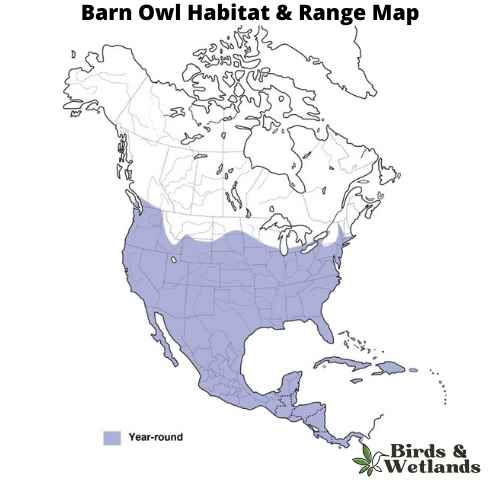
Barn Owl Sound
Scientific Name: Tyto alba
Length: 13 to 15 in
Wingspan: 31 to 37 in
Weight: 9.2 oz
The Barn Owl is a widespread species of owl known for its distinctive heart-shaped facial disc.
Barn Owls are medium-sized owls, they are pale overall with golden-brown wings and back, contrasted by a white face, chest, and belly. Their most notable feature is their heart-shaped facial disc, which helps channel sound to their ears.
Barn Owls are typically found in open habitats, including farmland, woodland, and marshes. They are named for their habit of nesting in human structures such as barns, church towers, and in the hollows of large trees. These owls are nocturnal, hunting at night and roosting during the day.
The diet of Barn Owls primarily consists of small mammals, particularly rodents such as mice and rats. They are known for their silent flight, which allows them to sneak up on their prey without detection.
Barn Owls have a unique nesting behavior. They do not build nests, but instead, lay their eggs directly on the bare surface of a secluded ledge or cavity. A female typically lays 4-7 eggs, and both parents help incubate the eggs and care for the chicks.
The long-eared owl (Asio otus)

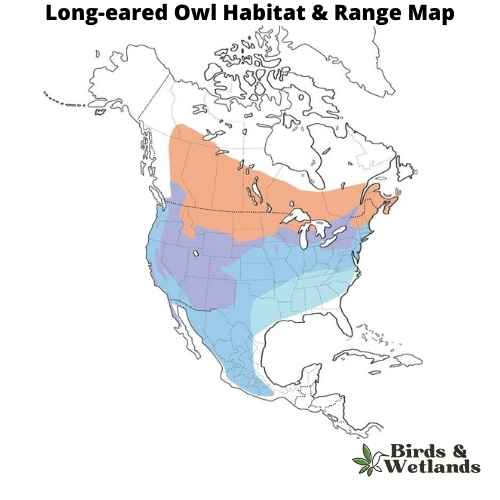
Long-eared Owl Sound
Scientific Name: Asio otus
Length: 12 and 16 in
Wingspan: 2 ft 10 in to 3 ft 4 in
Weight: 5.6 to 15.3 oz
The Long-eared Owl is a medium-sized owl species known for its distinctively long ear tufts, which can be raised or lowered depending on the bird’s mood or intention.
Long-eared Owls have mottled brown and cream plumage, which provides excellent camouflage among the trees. Their most distinctive features are their long, black-tipped ear tufts, which are set closer to the center of the head than in most other owl species.
These owls inhabit a wide variety of habitats, including deciduous and coniferous forests, woodlands, and even semi-deserts.
The Long-eared Owl’s diet primarily consists of small mammals, especially voles, but they will also take small birds and insects. They are skillful hunters, often capturing prey from a perch or in flight.
In terms of nesting behavior, Long-eared Owls do not construct their own nests, instead they take over old nests built by other bird species, usually those of corvids or other large birds. They lay an average of 4 to 5 eggs, which are incubated by the female while the male provides food.
Short-eared Owl (Asio flammeus)


Short-eared Owl Sound
Scientific Name: Asio flammeus
Length: 13–17 in
Wingspan: 33 to 43 in
Weight: 7.3–16.8 oz
The Short-eared Owl is a medium-sized owl species with a wide distribution, found across North and South America, Europe, Asia, and many Pacific islands. Despite its name, the “ears” of the Short-eared Owl are not often visible, as they are small and tend to blend with the bird’s feathers.
The owls are predominantly brown with buff and white accents throughout their body and wings, and dark patches around their yellow eyes.
Short-eared Owls diet consists largely of small mammals, especially voles. However, they are opportunistic hunters and will also prey on a variety of other animals, including other birds, when available.
Their habitat is characterized by open areas like grasslands, marshes, and tundra. They nest on the ground, which is unusual for owls, and this makes them vulnerable to ground predators. As such, they often live in areas with tall grasses or other ground cover for protection.
Northern Saw-whet Owl (Aegolius acadicus)

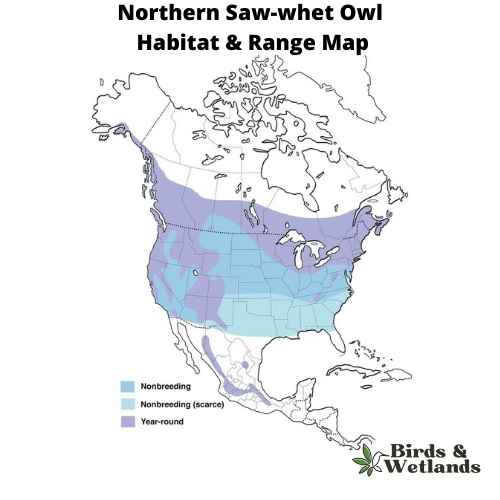
Northern Saw-whet Owl Sound
Scientific Name: Aegolius acadicus
Length: 17–22 cm (6.7–8.7 in)
Wingspan: 42–56.3 cm (16.5–22.2 in)
Weight: 54 to 151 g (1.9 to 5.3 oz)
The Northern Saw-whet Owl is a tiny, speckled gray owl and it’s one of the smallest owls in North America. It’s also known as the Little Owl or Wood Owl in some areas.
Northern Saw-whet Owls have dark brown eyes, white eyebrows, and yellow beak. It has brownish-grey feathers that are spotted with white. The owl’s legs are covered in feathers and appear nearly invisible when the bird is perched on a branch or tree.
In the winter they migrate south to warmer climates. They prefer to live in dense coniferous forest with large trees but will occasionally nest in shrubs or other vegetation that can protect them from predators.
The Northern Saw-whet Owl eats mice and voles (small rodents), small birds, frogs, salamanders, moles and shrews, but unlike most owls they chop their prey up and spread over a few meals. They will also eat insects like beetles and grasshoppers if they are available. It hunts from a perch at night using its excellent hearing to locate prey items within about 30 feet (9 meters) of its nest.
These owls nest in tree cavities usually located close to water sources such as lakes or rivers where they can find their food source (insects). They lay 2-4 eggs at one time which incubate for about 30 days before hatching.
Snowy owl (Bubo scandiacus)
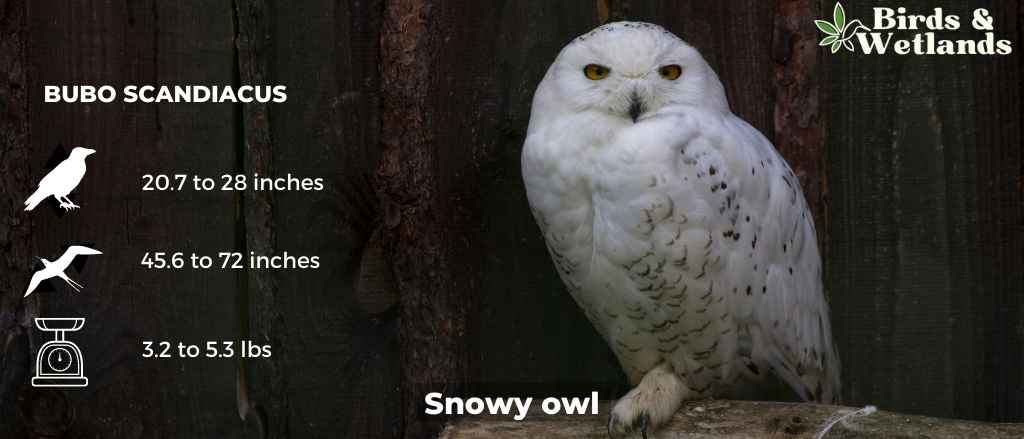
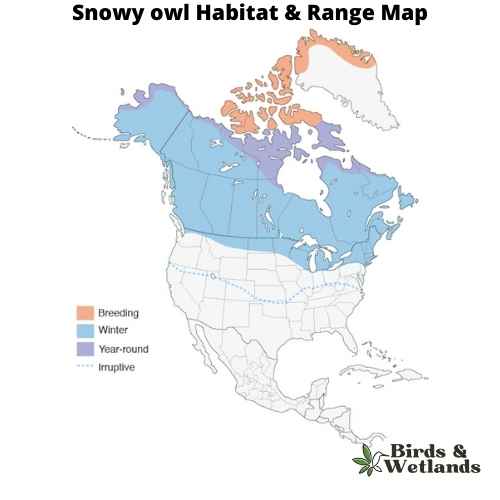
Snowy owl Sound
Scientific Name: Bubo scandiacus
Length: 20.7 to 28 in
Wingspan: 3 ft 10 in to 6 ft 0 in
Weight: 3.2lb to 5.3lb
The Snowy Owl, is of the most well-known species of owls, the Snowy Owl is renowned for its striking appearance and adaptations to its extreme environment.
Snowy Owls are medium sized birds that possess a rounded head, yellow eyes, and a black beak. The most distinctive feature of the Snowy Owl is its white plumage, which provides effective camouflage in its snowy habitat. Male Snowy Owls are often almost completely white, while females and younger owls have more extensive dark barring on their plumage.
Unlike many owl species, Snowy Owls are primarily diurnal, which means they are active during the day. This is an adaptation to life in the Arctic, where there can be 24 hours of daylight in the summer. Their diet mainly consists of small mammals, particularly lemmings, but they are known to eat a variety of animals including birds, fish, and even carrion when necessary.
Snowy Owls nest on the ground, usually on a mound or boulder. Their breeding success is closely tied to the availability of food, and in good years a single pair of owls can raise a large brood of chicks.
Where to Spot New Hampshire’s Owls
White Mountain National Forest: This expansive forest offers the chance to spot a variety of owl species, including the Barred Owl, Great Horned Owl, and Northern Saw-whet Owl.
Pawtuckaway State Park, Nottingham: Known for its rich biodiversity, this state park is home to owls such as the Great Horned Owl and Barred Owl. Other owls sometimes spotted include the northern hawk owl.
Umbagog National Wildlife Refuge, Errol: This refuge straddling the New Hampshire-Maine border provides a habitat for several owl species, including the Great Horned Owl, Barred Owl, and Northern Saw-whet Owl.
Pisgah State Park, Winchester: The largest state park in New Hampshire, it is an excellent spot to find Barred Owls and Great Horned Owls.
Odiorne Point State Park, Rye: Though best known for its ocean views, this park also offers opportunities to spot Great Horned Owls and Barred Owls.
| State | Main Owl Watching Sites |
|---|---|
| Maine Owls | Acadia National Park, Moosehorn National Wildlife Refuge |
| Massachusetts Owls | Quabbin Reservoir, Wompatuck State Park |
| Vermont Owls | Green Mountain National Forest, Missisquoi National Wildlife Refuge |
Tips on How to Spot Owls in New Hampshire?
Locations: Consider visiting the White Mountain National Forest, the Great Bay National Wildlife Refuge, or the Lakes Region, which are known for their variety of bird species. State parks and local nature reserves are also good spots.
Timing: Owls are primarily nocturnal, so your best chance to see them is around dawn and dusk. Winter can be a great time to spot owls as they’re more active during their breeding season and the bare trees can make them easier to spot.
Listen for Calls: Familiarize yourself with the different calls of the owl species in New Hampshire. Listening for these calls can often lead you to their location.
Look for Signs: Owls can leave behind certain signs, such as pellets (balls of undigested food), white wash (droppings), or feathers. These can usually be found beneath roosting or nesting spots in trees.
Patience and Caution: Be patient and move quietly. Owls can be sensitive to noise and sudden movements, so approach any potential spotting location with care.
Equipment: A good pair of binoculars is essential for bird watching. A red-filtered flashlight can also be helpful for locating owls in the dark without disturbing them.
Join Local Birding Clubs: These organizations often have field trips and experienced members who can help you spot and identify different species of owls. They may also have up-to-date information on recent owl sightings.
Remember, never disturb an owl’s nest or use recordings to draw them out, as this can cause them unnecessary stress. Be respectful of the owls and their habitats while observing them.

